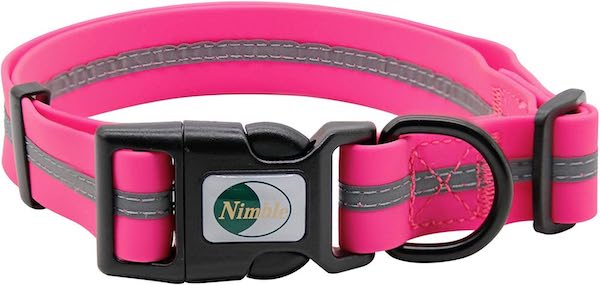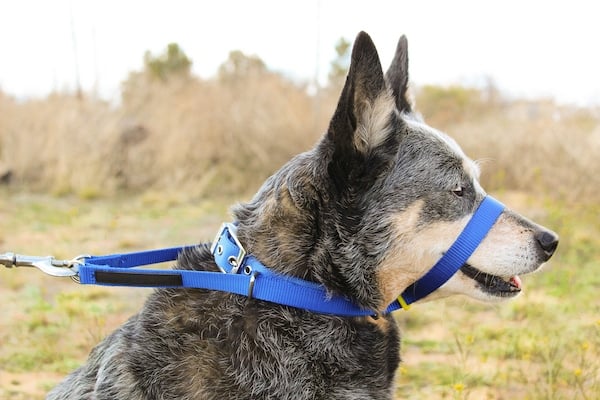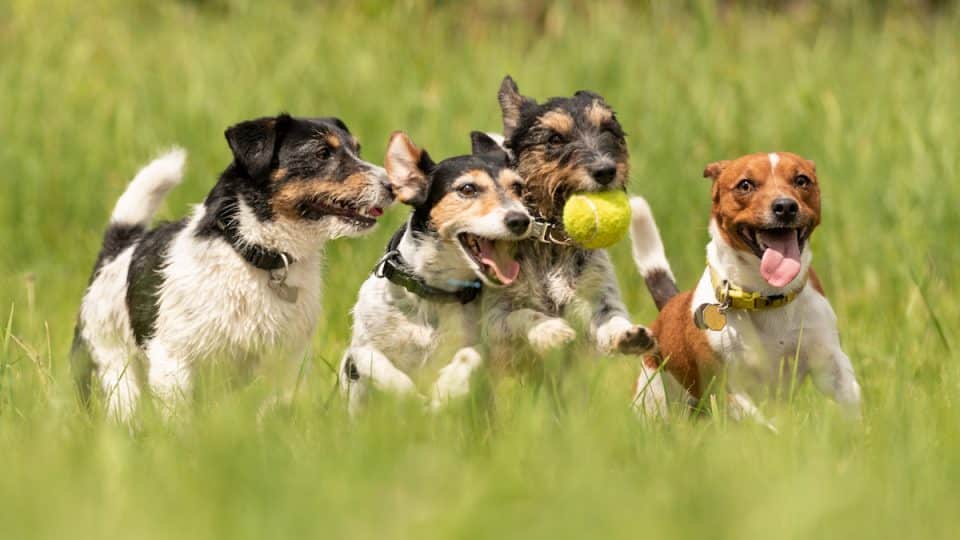- This post contains affiliate links. Read more here.
- Not a substitute for professional veterinary help.
Flat collars, head collars, martingales—oh my! A good collar rises to the top when it comes to essential dog gear. Even if your dog already wears a harness, they can benefit from pairing it with a collar to hold their ID tags. But with so many options available, choosing an appropriate dog collar can be confusing and overwhelming. What kind of collar will work best for your particular pup?
To narrow down your pool of potentials, it helps to focus on a few points, including your dog’s breed, size, fur length, and any training goals you may have. To make sense of all the options, we spoke with a professional trainer and a veterinarian who identified the various collars you’ll encounter—and which ones might perform best for your dog.
Seven Types of Collars—And The Dogs They Suit Best
Before zeroing in on a dog collar, it’s helpful to understand the different types and how they work. Here’s a rundown of seven types of dog collars, with more details below.
| Collar Type | What They Look Like | What They’re Good For |
| Flat nylon collars | Standard collars that lay against your dog’s neck. They typically feature a quick-release buckle for convenient outfitting. | Work well for most dogs, especially those with good leash manners who don’t pull. Ideal for attaching ID tags. |
| Waterproof rubber collars | Usually made with flexible biothane or PVC-coated material, these repel water and wet-dog smell. | Water-loving dogs who like to swim and explore. |
| Leather collars | Chic and classic, leather is strong and long-lasting. | Rolled leather is ideal for coats prone to matting or tangles. |
| Martingale collars | Composed of two loops of fabric, these tighten slightly when dogs pull or attempt to break away. | Prevents escape artists from backing out of a collar. Also ideal for sighthounds with heads smaller than their necks. |
| GPS or smart collars | Standalone tracking devices can attach to your dog’s regular collar. Other models integrate a tracking device right on the collar. | Allows you to monitor escape artists or dogs being walked by a sitter. Some can also track your dog’s health. |
| Head collars | Similar to a horse halter. Two loops of fabric go over a dog’s neck and snout. | Offers gentle yet effective control for big dogs who pull. |
| Choke, shock, and prong collars | Choke collars tighten when a dog pulls; prong collars press sharp spokes into a dog’s neck, and shock collars emit an electric shock, vibration, or foul smell to deter unwanted behavior. | Most experts advise against aversive tools for walking and training, as they can cause more harm than good. |
Flat collars are a comfortable nylon default

Image via Flickr
Easily the most familiar and popular collar type, a basic flat buckle collar can work well for most dogs. These lay flat against your dog’s neck and provide an attachment for securing ID and rabies tags. Even if your dog already wears a harness for walking, using a flat collar to hang their identification is still a good idea.
Generally speaking, a basic, no-frills flat collar is a comfortable and affordable starting point for dogs being acclimated to wearing equipment. Most feature a quick-release buckle to make it simpler to put on and take off—ideal for squirmy, excitable puppies or rescues who may be initially wary of walking gear.
Materials vary, but nylon is pretty standard. This material is durable, lightweight, and easy to clean, says Dr. Kathryn Rosalie Dench, a veterinary surgeon and advisor for Gentle Dog Trainers. Accordingly, a flat nylon collar makes a viable option for comfy everyday wear, especially for small breeds.
The Blueberry Pet Classic Nylon Collar, for instance, is a straightforward and functional flat buckle collar. It gives pet parents a place to hang ID tags and is adjustable for the perfect fit. Like other flat collars, it’s best suited for dogs with good leash manners who aren’t liable to back out of a collar.
Waterproof rubber collars dry fast and repel odors
According to Dr. Dench, waterproof collars are ideal for water-loving dogs, like Labs or Retrievers, or those who enjoy outdoor activities in wet conditions.
These come in different materials, including Biothane and PVC-coated nylon or polyester, like the Nimble Waterproof Collar. These materials are designed to repel water—and the stink that comes with it. Mud and sweat are also kept at bay. Plus, most waterproof collars are easy to clean: just rinse with water or wipe down with a damp cloth.

Waterproof collars like the Nimble aren’t always as comfortable as flat nylon, but they smell a lot better after a week of rainy walks.
A waterproof collar makes the most sense for dogs who like swimming or frequently walk in rainy or muddy conditions. However, the material tends to be stiffer, so they’re not great for all-day wear or dogs with sensitive skin.
Leather collars are classy, durable, and sometimes pricey
“Leather provides a classic and stylish look while being soft and comfortable,” remarks Dr. Dench. These tend to be more expensive than other collars, but leather can last a long time if properly cared for.
Leather collars can be flat or take a rounded design. Rolled leather benefits dogs prone to matting, such as Poodles, Rough Coated Collies, Doodles, Yorkies, or any dog with long fur or a double coat. For example, collars like the Coastal Pet Rounded Leather Collar shouldn’t pull at long hair.
A potential downside of leather is its usually steep cost: it may not be your first choice if you’re on a tight budget. Likewise, you may want to pass if you have a tiny toy breed, as leather tends to be heavier than other materials. And while a little rain is no problem, leather can break down when submerged entirely, so it’s not optimal for lake-bound pups.
Martingale collars are for escape artists and sight hounds
These collars look similar to flat collars, with one key difference. Martingales have a second smaller loop that lets the collar tighten gently when a dog pulls. “A martingale, also known as a limited-slip collar, is designed to slightly tighten to prevent a dog from backing out it,” says Dee Hoult, CEO and head trainer at Applause your Paws, Inc.
Unlike aversive choke collars, a martingale is limited in how much they can tighten. When used properly, they’re considered safe and won’t cause choking or harm to a dog’s neck. The PetSafe Martingale Collar, for example, remains comfortably loose during relaxed walks and only tightens when a dog pulls.

funstickers via iStock
As Hoult explains, martingales offer security for dogs who might otherwise back out of a traditional flat collar. This makes them particularly fitting for dogs with slender heads, like Greyhounds, Whippets, and other sighthounds who can easily slip out of most collars. Martingales are also a safe choice for anxious dogs who might try backing out a collar when spooked.
For training purposes, a martingale can offer gentle control while communicating corrections with your dog through the leash. However, they’re not the best choice for relentless pullers who may fare better with a no-pull harness.
GPS and smart collars can offer peace of mind
Today’s GPS collars offer peace of mind to pet parents who need to keep eyes on their dog’s whereabouts. Escape artists, for one, are prime candidates, as are dogs frequently walked by a sitter.
Each model operates differently: some use GPS, others rely on radio frequency or Bluetooth technology. Some, like the Whistle Go Explore, are designed as compact tracker devices that attach to your dog’s regular collar. Others, like the Fi Series 3 Smart Collar, include a collar and tracker in one. Both include aspects of health tracking, like step counting and sleep monitoring, as part of the growing dog Fitbit trend.
One downside of these devices is their steep cost. On top of the collar or tracker, many require monthly subscription fees. Also, smaller dogs and puppies may find them too bulky for comfort.
Head collars are gentle ways to redirect pulling
Inspired by horse halters, head collars operate similarly. They feature two loops: one goes over a dog’s neck, and the other fits over their snout. Admittedly, head collars can look imposing—cruel, even. But unlike muzzles, they don’t keep dogs from panting, drinking, or barking. And when appropriately sized and used correctly, head collars are considered safe for training by most experts.

Wind Wolf Photography via iStock
Some head collars will have a leash connection under the dog’s chin, and others will connect behind the ears. Whatever model you use, all head collars share the same goal: to redirect pulling and offer handlers more control over their dog’s movements.
Two popular head collars include PetSafe’s Gentle Leader and the Halti OptiFit. Many handlers find them an effective training tool, especially for bigger dogs who pull. However, bear in mind there’s a learning curve to these, and dogs will need a period of adjustment to become accustomed to wearing them.
Working with a professional trainer can help determine if your dog is a good candidate for a head collar. Plus, they can offer guidance on proper sizing, how to put it on correctly, and how to use this type of equipment safely. A head collar won’t work for every dog, though, and should be avoided with dogs with neck injuries or those at risk of tracheal collapse.
Choke, shock, and prong collars aren’t a good idea
Aversive collars rely on discomfort and pain to elicit a desired response in dogs. Choke collars are usually made with metal chains that tighten when a dog pulls. Prong collars are ringed with metal tines that press into a dog’s neck when there’s tension on the leash. And shock collars elicit painful shocks, startling vibrations, or aversive smells to discourage bad walking habits.
Most experts agree these types of tools inflict more harm than good. Not only can they injure a dog, but they also stand to halt any training progress. A front-clip harness, head collar, or martingale may be suitable alternatives for training.
How To Choose a Dog Collar for Your Unique Pup
Now that you’ve brushed up on the different types of dog collars, it’s time to consider which ones make the most sense for your unique circumstances. As you’ll see in the chart below, this will depend on a few factors, including your dog’s size, breed type, anatomy, hair length, and walking habits.
| Type of Dog | The Collars That Work Best for Them | Why They Work |
| Dogs who pull | Head collars & no-pull front-clip harnesses | When big dogs pull, a head collar gently redirects their attention back to their handler. |
| Big, powerful dogs | Any collar that’s made with strong, durable materials | Big, strong dogs need a collar that can withstand their impressive strength. |
| Growing puppies | Flat collars, martingales, highly adjustable collars | Standard flat collars are typically lightweight, comfy, and adjustable for growing bodies. And martingales offer a degree of safety for nervous pups who might try to escape. |
| Dogs in training | Martingales or head collars | These offer gentle control without harming your dog. |
| Escape artists | Martingale (attached with a dual-leash to a harness offers the best support) | Tighten slightly (but not too tight!) to prevent dogs from backing out of their collar. |
| Sighthounds (or dogs with heads smaller than their necks) | Wide martingales | A wider martingale offers the best security for these slender-headed dogs. |
| Dogs prone to matting | Rolled leather | Designed to prevent tangles, these are soft and won’t rub or catch long hair. |
| Dogs at risk of catching their collar on things | A loosely fitted nylon collar | If your dog gets snagged on something, these will be easier to back out of. |
I have a dog who pulls
Walking a relentless puller can be exhausting. Is there a collar that can help?
“My preference has always been a head halter, which gives you a lot of control over the dog’s movement without the risk of choking your dog,” says trainer Dee Hoult. She adds that head collars take a bit of pre-training to use. Moreover, many dogs will find them uncomfortable at first, and most pups will need a period of desensitization to become acclimated to this type of collar.
Additionally, you may want to consider using a no-pull harness, which can safely temper your dog’s pulling without putting excess pressure on their neck.
I have an especially big or powerful dog
Dr. Dench says big dogs need a collar that can hold up to their powerful strength.
“Larger breeds benefit from sturdy, wide collars with strong buckles for added durability,” she explains. In most cases, nylon or leather can work well. In addition, look for features like box stitching and metal hardware.
Naturally, size also weighs in here. Try to prioritize collars with a range of adjustability for the best fit.
I have a growing puppy
A good puppy collar will be lightweight and adjustable to accommodate growing bodies, says Dr. Dench. Typically, flat nylon collars are suitable for puppies because they’re easy to get on and off, and they’re adjustable.
Since they’ll be new to wearing walking equipment, try to look for something comfortable. Soft fabrics and neoprene padding can be beneficial for puppies. Finally, when used properly and sized correctly, a martingale collar can also be a good tool for helping your puppy master walking basics.

diane39 via iStock
I have a dog in training
For training purposes, the best collar will depend on the individual dog, remarks Hoult. “We’re often limited by the type of equipment we can use for training based on the age and size of a dog, as well as the shape of their face,” she explains.
Generally speaking, Hoult recommends using a harness for training young pups, eventually moving on to a well-fitted nylon martingale or head halter if pulling is a primary concern. These can both promote better leash manners when used appropriately.
I have an escape artist
Dr. Dench recommends using a secure-fitting harness or a martingale collar for Houdini dogs or pups who slip out of regular flat collars. You can even use a martingale collar in tandem with your pup’s harness for extra security.
I have a sighthound or slim-necked breed
The unique anatomy of sighthounds like Salukis and Greyhounds presents a challenge when finding a collar that will stay put. Because their heads are smaller than their necks, these dogs can easily slip out of a regular collar.
According to Hoult, a wide martingale collar is the safest option because it’s designed to prevent slipping and can accommodate their distinctive neck shape.
I have a dog prone to matting
Rolled leather is often recommended for long-haired dogs with a tendency to mat around the neck. The leather is smooth, and the rounded design glides over hair to reduce painful friction.

TRAVELARIUM via iStock
I’m worried about my dog’s collar getting caught
Hoult reassures us that the likelihood of a dog getting their collar hung up on things is very slim.
“But if you’re still worried about a collar getting caught somewhere, it’s best to leave a loosely fit nylon flat collar on your dog for ID,” she says, adding that these will be easier to back out of should they become caught.
Experts Answer Some Common Questions About Dog Collars
Are different collars better suited for different situations?
For Dr. Dench, the answer is a definite yes. “For example, a sturdy and well-fitted collar is essential for daily walks, while a GPS or reflective collar might be useful for nighttime walking,” she explains.
Similarly, a waterproof collar makes sense for trips to the lake, whereas a leather collar may prove more comfortable for everyday use. And for training, you’re probably looking at a martingale or a head collar.
Does this mean all dogs need to have more than one collar? Not necessarily—but having a couple of types handy to meet different needs can be a significant convenience for some pet parents.
“Most dogs benefit from having at least one well-fitted everyday collar and another for special purposes, such as training or identification during travel,” Dr. Dench explains.
Should dogs wear collars in the house?
There’s a lot of back-and-forth on this question. Some argue that wearing a collar indoors presents a safety risk, while others maintain that dogs should always wear a collar for easy identification. There’s no perfect answer; ultimately, pet parents will need to weigh their dog’s comfort and safety to decide for themselves.
Dr. Dench offers this advice: “As long as the collar is comfortable and doesn’t cause any issues, dogs can wear their collars indoors. However, some pet parents may prefer to remove collars when their dogs are indoors for safety and comfort reasons,” she adds.
How We Chose
The collars featured here were selected based on a combination of our own hands-on testing, a comprehensive look at customer reviews, and interviews with veterinarian Dr. Kathryn Dench and professional trainer Dee Hoult. We considered a range of dog types of different dog parent goals. Additionally, we prioritized collars that were durable, comfortable, and highly adjustable. We’re also guided by the experience of living and playing alongside our own much-loved and strongly opinionated pets, who are never stingy with their feedback.





